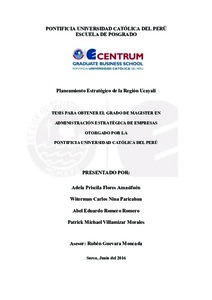| dc.contributor.advisor | Guevara Moncada, Rubén | |
| dc.contributor.author | Flores Amasifuén, Adela Priscila | es_ES |
| dc.contributor.author | Nina Paricahua, Witerman Carlos | es_ES |
| dc.contributor.author | Romero Romero, Abel Eduardo | es_ES |
| dc.contributor.author | Villamizar Morales, Patrick Michael | es_ES |
| dc.date.accessioned | 2017-01-31T17:36:35Z | |
| dc.date.available | 2017-01-31T17:36:35Z | |
| dc.date.created | 2016 | |
| dc.date.issued | 2016-06 | |
| dc.identifier.uri | http://hdl.handle.net/20.500.12404/7593 | |
| dc.description.abstract | El presente trabajo tuvo como objetivo analizar e identificar las oportunidades, amenazas, fortalezas y debilidades relacionadas con la región Ucayali y en base a ella formular las estrategias adecuadas para alcanzar la visión y misión propuestas para la región. También se llevó a cabo un análisis de la competitividad del Perú y de la región Ucayali usando el Diamante Competitivo de Porter lo que permitió identificar las ventajas competitivas y la relativa posición de la región frente a sus más cercanos competidores dentro del ámbito nacional como el internacional.
Entre los principales hallazgos se encontraron actividades económicas primarias y atractivos turísticos y ecológicos con un gran potencial así como reservas proadas de gas e hidrocarburos y una ubicación estratégica con Brasil y con salida al Atlántico todo ello como fortalezas; como debilidades se encontró infraestructura e inversión pública insuficiente para atraer inversiones y altas tasas de depreciación forestal. Con respecto a las oportunidades se tiene importantes acuerdos internacionales como los TLC y una demanda alta de gas e hidrocarburos y un potencial crecimiento en el sector turismo; con respecto a las amenazas la región posee acceso restringido a los servicios de salud, agua y desagüe, un bajo nivel en la educación y con una sobrepoblación en las principales ciudades.
A la vez se definieron interés organizacionales de la región como mejorar la calidad de vida de los pobladores, fortalecer la educación, incrementar el PBI y lo que permita incrementar la competitividad de la región, en base a ello se implementaron estrategias que permitan alcanzar la visión y misión planteada como son desarrollar productos en base a la biodiversidad disponible de la región, incrementar las exportaciones de gas natural e hidrocarburos aprovechando los TLC, desarrollar el talento en la población para satisfacer las necesidades en las industrias primarias, turismo y ecología, entre otras | es_ES |
| dc.description.abstract | This study aimed to analyze and identify opportunities, threats, strengths and weaknesses related to the Ucayali region and based on it make appropriate to achieve the vision and mission proposed strategies for the region. Also conducted an analysis of the competitiveness of Peru and the Ucayali region using the Competitive Diamond Porter allowing identify competitive advantages and the relative position of the region against its closest competitors in the national and international. Among the main findings tourist and ecological attractions and primary economic activities with great potential and reserves of gas and hydrocarbons proadas and strategic location with Brazil and exit to the Atlantic all as strengths were found; as weaknesses and insufficient infrastructure to attract investment and high rates of forest found public investment depreciation. With respect to the opportunities you have important international agreements such as NAFTA and a high demand for gas and hydrocarbon potential growth in the tourism sector; with respect to threats to the region has limited health services, water and drainage, low education and overcrowding in major cities access. While organizational interest in the region and improve the quality of life of the people, strengthen education, increase PBI and so as to increase the competitiveness of the region, based on that strategies were implemented that achieve the vision defined and mission raised as they are developing products based on the available regional biodiversity, increase exports of natural gas and hydrocarbons leveraging TLC, develop talent in the population to meet the needs in primary industries, tourism and ecology, among others | es_ES |
| dc.language.iso | spa | es_ES |
| dc.publisher | Pontificia Universidad Católica del Perú | es_ES |
| dc.rights | Atribución-NoComercial-SinDerivadas 2.5 Perú | * |
| dc.rights | info:eu-repo/semantics/openAccess | es_ES |
| dc.rights.uri | http://creativecommons.org/licenses/by-nc-nd/2.5/pe/ | * |
| dc.subject | Planificación regional | es_ES |
| dc.subject | Planificación estratégica | es_ES |
| dc.title | Planeamiento estratégico de la Región Ucayali | es_ES |
| dc.type | info:eu-repo/semantics/masterThesis | es_ES |
| thesis.degree.name | Magister en Administración Estratégica de Empresas | es_ES |
| thesis.degree.level | Maestría | es_ES |
| thesis.degree.grantor | Pontificia Universidad Católica del Perú. CENTRUM | es_ES |
| thesis.degree.discipline | Administración Estratégica de Empresas | es_ES |
| renati.advisor.orcid | https://orcid.org/0000-0002-4795-2557 | es_ES |
| renati.discipline | 413307 | es_ES |
| renati.level | https://purl.org/pe-repo/renati/level#maestro | es_ES |
| renati.type | https://purl.org/pe-repo/renati/type#tesis | es_ES |
| dc.publisher.country | PE | es_ES |
| dc.subject.ocde | https://purl.org/pe-repo/ocde/ford#5.02.04 | es_ES |






